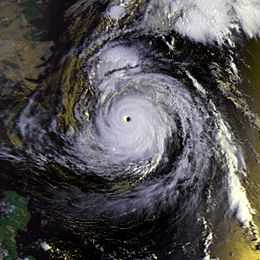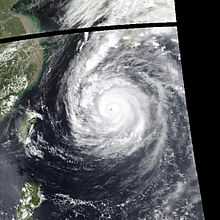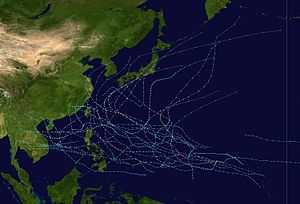Typhoon Flo (1990)
| Typhoon (JMA scale) | |
|---|---|
| Category 5 (Saffir–Simpson scale) | |
 Super Typhoon Flo at peak intensity | |
| Formed | September 8, 1990 |
| Dissipated | September 22, 1990 (extratropical after September 20) |
| Highest winds |
10-minute sustained: 220 km/h (140 mph) 1-minute sustained: 270 km/h (165 mph) |
| Lowest pressure | 890 mbar (hPa); 26.28 inHg |
| Fatalities | 38 dead, 12 missing, 90 injured |
| Damage | $4 billion (1990 USD) |
| Areas affected | Japan |
| Part of the 1990 Pacific typhoon season | |
Super Typhoon Flo was a powerful Category 5 typhoon that killed over 30 people and caused over $4 billion (1990 USD) in damages when it struck Honshū, Japan in mid-September 1990. The twelfth typhoon and first super typhoon of the 1990 Pacific typhoon season, it formed on September 8, as Tropical Depression 20W. It reached typhoon status on September 15, 1990. It rapidly intensified on the 16th and 17th to a 165 mph super typhoon near Okinawa. Vertical shear weakened it as it recurved to the northeast, and Flo hit Honshū on the 19th as a 155 km/h (100 mph) typhoon. It continued rapidly northeastward, became extratropical on the 20th, and dissipated on the 22nd.[1]
Widespread flooding and landslides killed thirty-two people and caused billions of dollars in property damage. Typhoon Flo was the costliest typhoon in the West Pacific at the time. Now it ranks as the 6th costliest Western Pacific typhoon of all time, only to be surpassed by Typhoons Mireille, Songda, Fitow, Prapiroon and Herb.[2]
Meteorological history


Tropical Depression 20W developed over the waters about 430 kilometers (270 miles) east-southeast of Guam on September 8 and tracked steadily northwestwards over the next four days. The system reached Tropical Storm strength and was assigned the name Flo. During that time, it rapidly intensified and attained typhoon intensity about 780 kilometers (480 miles) southeast of Okinawa on the evening of September 15.[3]
Flo reached peak intensity on September 16 with maximum sustained winds of 270 km/h (165 mph) and a minimum central pressure of 891 mbar (hPa; 26.31 inHg), making it the strongest storm of the 1990 season, and one of the strongest tropical cyclones ever recorded.[4] Approaching the Ryukyu Islands, it recurved on September 17 towards Japan.[3]
Accelerating on September 19, 155 km/h (100 mph) Category 2 Typhoon Flo made landfall the south coast of Honshu that evening and weakened rapidly over land to a tropical storm about 240 kilometers (150 miles) northeast of Osaka. Flo became an extratropical cyclone on September 20 as it moved over the waters east of northern Honshu. The remnants of former Typhoon Flo continued to move northeast, and the extratropical low dissipated completely on September 22.[3]
Impact
As Typhoon Flo battered the coast of Honshū, it caused 155 km/h (100 mph) wind gusts and dumped up to over 2 feet (610 mm) of rain, resulting in very deadly floods. The storm also triggered a series of catastrophic landslides which left four dead, thirteen missing, and fourteen people missing.[5]
Flooding destroyed tens of thousands of homes and roads, causing landslides and leaving at least 38 people dead. Heavy rains caused flooding and landslides in western and northern Japan before the typhoon headed out to sea off the coast of Iwate prefecture.[6] Flood warnings were issued on September 19 for Tokyo, Yokohama, and Chiba.[7]
Before the flood warnings was issued, a full night and morning of heavy rains caused torrential flooding and landslides throughout the nation's western and southern portions before it went out from the Iwate Prefecture and out into sea.[8]
The typhoon's three-day rampage across the nation left about thirty people dead, nine people missing and ninety injured. Eleven of the victims died in a landslide that happened on September 19 on Amami Island in the southern portion of the nation.[8]
Television stations showed scenes from throughout the nation, including village streets in muddy water from floods that are from heavy rains, over-turned vehicles and washed out roads. Damage was reported in 44 of the island nation's 47 prefectures. Flo brought very high winds and very light rain to Tokyo, but the capital remained largely unimpacted.[8]
On Okinawa and the island chains near Okinawa, Flo brought powerful and violent 140 km/h (90 mph) winds and torrential rainfall. Three Minor injuries were reported, but the high winds and torrential rain made transportation, such as flights on Okinawa's airport, to halt, and several other Japanese islands had no electricity because of the violent winds. In Okinawa's capital, Naha, about 1,500 kilometers (930 miles) south of Tokyo, the very powerful winds destroyed neon signs, tore away store-front shutters and tossed bicycles across streets.[9]
With U.S Military Bases going on typhoon alert on September 17, the military newspaper, Stars and Stripes reported. More than 25,000 military personnel in the base were stationed on the island. Typhoon Flo was regarded as the worst typhoon to hit the nation since the 1959 season.[5][9]
Records
| Rank | Storm | Season | Cost (2015 USD) | |
|---|---|---|---|---|
| 1 | Mireille | 1991 | $17.3 billion | |
| 2 | Songda | 2004 | $11.2 billion | |
| 3 | Fitow | 2013 | $10.5 billion | |
| 4 | Prapiroon | 2000 | $8.22 billion | |
| 5 | Herb | 1996 | $7.52 billion | |
| 6 | Flo | 1990 | $7.22 billion | |
| 7 | Rammasun | 2014 | $7.13 billion | |
| 8 | Bart | 1999 | $7.08 billion | |
| 9 | Morakot | 2009 | $6.82 billion | |
| 10 | Maemi | 2003 | $6.15 billion | |
| Source: International Disaster Database: Disaster List | ||||
Typhoon Flo was the costliest typhoon at the time. Now it ranks as the fifth most destructive typhoon of all time, only typhoons Mireille, Songda, Fitow, and Prapiroon are much more destructive than Flo.[2] Flo is also regarded as the worst typhoon to hit Japan in more than thirty years. Flo also attained a minimum pressure recording of 891 mbar (hPa; 26.31 inHg), low enough to make it tied to be the 14th most intense tropical cyclone in the Western Pacific proper, tied with typhoons Nancy of 1961, Emma of 1962, Amy of 1971, Wynne of 1980, and Betty of 1987.[4]
See also
References
- ↑ "Flo report" Joint Typhoon Warning Center. Retrieved 01-15-12.
- ↑ 2.0 2.1 "Costliest natural disasters list" The International Disasters Database. Retrieved on 1-14-12.
- ↑ 3.0 3.1 3.2 "Tropical Cyclones of the 1990 Pacific Typhoon Season" (PDF). Hong Kong Observatory. 1991. Retrieved 2012-01-15.
- ↑ 4.0 4.1 "Western North Pacific Typhoon best track file 1951-2015". Japan Meteorological Agency. 2010-01-13. Retrieved 2012-01-15.
- ↑ 5.0 5.1 "台風Floは日本に上陸しています". The Beaver County Times (in Japanese). September 19, 1990. Retrieved 2012-01-15.
- ↑ "Typhoon Flo slams into Japan" Mercury News. Retrieved 1-15-2012.
- ↑ "Typhoon Batters Japan". The Pioneer Press. Retrieved 2012-01-15.
- ↑ 8.0 8.1 8.2 "Typhoon Flo slams into Japan". The Tuscaloosa News. September 20, 1990. Retrieved 2012-01-15.
- ↑ 9.0 9.1 "台風Floは沖縄にスラム". The Lodi News-Sentinel (in Japanese). September 18, 1990. Retrieved 2012-01-15.
External links
| Wikimedia Commons has media related to Typhoon Flo (1990). |
| |||||||||||||
